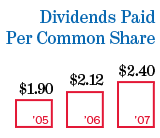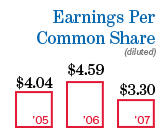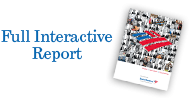Many of us had known for some time that these accelerating trends were unsustainable over the long term. We took several steps in late 2006 and the first half of 2007 to adjust our business to evolving market trends. But what we didn't know was how and when the cycle would turn fully, and how the market adjustments would play out.
Now we know - the failure of several large hedge funds in July caused the credit markets to seize up completely in August. All market participants were impacted at the same time, and every deal was caught, as investors struggled to price risk in the market. Late in the year, ratings agencies aggressively downgraded mortgage-backed securities that had been rated AAA, which contributed to the large asset writedowns and financial losses across the industry in the fourth quarter.
Two areas that hit banks hardest were collateralized debt obligations, or CDOs, and structured investment vehicles, or SIVs. Both are financial instruments - asset-backed borrowings in the simplest view - that banks and investors have used to fund the mortgage markets. At Bank of America, our exposure in CDOs was significant. Writedowns of the value of these securities reached $5.6 billion, which was one major cause of our weak fourth-quarter performance. Our losses in SIVs, by comparison, were relatively small.
The other major cause was the continued rise in credit costs, which drove rapidly expanding provision expense - money we set aside to cover loan losses - as consumer credit quality has fallen from historically high levels to more normal levels, affecting most market segments.
These factors were evident in our financial results for the year.
In 2007, Bank of America earned $15.0 billion, down from $21.1 billion in 2006. Earnings per diluted share fell to $3.30 from $4.59; revenue fell to $68.1 billion from $73.8 billion; and return on common shareholders' equity fell to 11.08 percent from 16.27 percent. Our efficiency ratio, which had been in our target range (under 50 percent) for the past two years, rose to 54.37 percent. Provision expense rose 67 percent to $8.4 billion from $5.0 billion, as nonperforming loans and leases and net charge-offs rose to 0.64 percent and 0.84 percent of total loans and leases, respectively.
The good news is that our core businesses continue to execute their growth strategies in the marketplace with precision and discipline. In Global Consumer & Small Business Banking, revenue rose 6 percent for the year, and noninterest income rose 13 percent. We added more than two million net new retail checking accounts for the second year in a row, opened nearly 14 million new Card Services accounts, became a leading direct-to-consumer mortgage and home equity originator and extended our leadership in the online banking and bill-pay business to lead the industry in mobile banking, with more than 600,000 active new accounts.
In Global Wealth & Investment Management, revenue was up 8 percent for the year, as record brokerage income and a 26 percent increase in asset management fees produced a 10 percent rise in noninterest income. In Premier Banking & Investments (PB&I), revenue rose 9 percent on 22 percent growth in investment and brokerage services and 19 percent growth in fee-based assets.
In Global Corporate & Investment Banking, net revenue from Business Lending rose 10 percent and average loans and leases rose 14 percent, demonstrating that we are making progress in deepening relationships with our commercial and corporate clients.
It was our company's diverse earnings mix that enabled us to remain profitable despite extremely challenging conditions. And it is our continued profitability, liquidity and balance sheet strength that have enabled us to sustain our dividend at a time when others have not. Overall, 2007 was our 30th consecutive year of raising our quarterly dividend, which increased by 14 percent to $0.64 per share. Over that time, our dividend has increased at a compound annual rate of 13 percent.
To bolster our capital ratios in the first quarter of 2008, we raised almost $13 billion in two preferred stock offerings, and could have raised twice as much, demonstrating investors' confidence in our company. Bank of America will continue to be characterized by strong cash flow and attractive returns for shareholders, tremendous liquidity and a fortress balance sheet. And we are still focused on achieving our long-term financial goals, including 6 to 9 percent revenue growth, 2 to 4 percentage points in operating leverage and 10 percent average annual earnings-per-share growth.



|
Choose e-Delivery of the Annual Report Download a PDF of the Print Edition |
 |
||
| © 2008 Bank of America Corporation. All rights reserved. | |||
